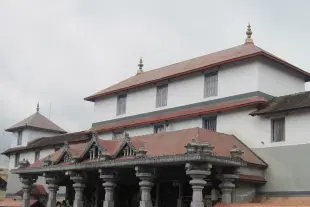Karnataka
A Karnataka Temple Under Siege: How Congress Turned Rumour Into Collective Trauma
Surabhi Hodigere
Sep 03, 2025, 11:12 AM | Updated 11:14 AM IST
Save & read from anywhere!
Bookmark stories for easy access on any device or the Swarajya app.


Karnataka has passed through an ordeal that was less an event than an atmosphere, one marked by dread, suspicion, and unresolved accusation. At its centre stood Dharmasthala, long regarded as an institution of trust and service, suddenly cast in a theatre of atrocity.
The allegations that hundreds of women had been raped, silenced, and buried in mass graves were not just legal claims. They were moral detonations that unsettled the deepest instincts of society. In a culture where temples are woven into daily rhythms, such accusations carried the power to make people wonder whether sanctuaries could still be trusted.
The Congress government did not steady the situation. Its first duty was to verify, to clarify, and to prevent rumour from mutating into fear. Instead, it vacillated. Chief Minister Siddaramaiah dismissed the need for an SIT, only to constitute one days later.
Health Minister Dinesh Gundu Rao acknowledged that left organisations had pressed for an SIT, which amounted to an admission that governance was responding to pressure rather than evidence. The Deputy Chief Minister spoke of conspiracy, adding yet another contradiction. Each of these statements, rather than calming the public, deepened its disquiet. When leaders cannot agree on what is unfolding, citizens cannot know whom to trust.
Certain images became seared into memory. The masked figure of CN Chinnayya holding a skull and a note was one such moment. It travelled far faster than official clarifications could. For days, his performance was replayed, dissected, magnified. Soon there were excavations. High-tech instruments were deployed, sites cordoned off, and there was digging upon digging, as though the sheer repetition of the act would guarantee discovery.
These images created their own authority. They persuaded people that something must lie beneath the earth, even when no evidence had yet emerged. The government, which should have been the custodian of proportion, stood aside. By its silence, it allowed spectacle to become a substitute for truth.
Later, contradictions surfaced. Forensic reports suggested the initial skull had not been exhumed from Dharmasthala. Yet the government offered little clarity. The obvious questions were not asked with urgency. Where did the skull come from? Who placed it in Chinnayya’s hands? Why was he moving between states, to Delhi and back, with such ease and confidence?
Arrests were made eventually, but only after weeks of theatre had already damaged public trust. At one point, Chinnayya was flanked by lawyers, once arriving in a fortified car with legal teams at his side. Later, as the story collapsed, he was left without even basic legal representation. He was used to generate fear, then discarded. The whistleblower was not a truth-teller. He was a pawn.
If Chinnayya embodied fear, Sujata Bhatt embodied grief. She spoke of a daughter, Ananya, who had been raped, abused, and buried. Later reporting suggested that this daughter may never have existed, that a name and even a photograph were fabricated.
To invoke the image of a daughter brutalised is to open the deepest reservoirs of empathy in a society. If such a story collapses, it leaves not just disillusion but anger. Mothers and daughters had been made to mourn a life that was never there.
Once again, the government had done nothing to verify before panic spread. It allowed the narrative to linger untested, and in doing so it betrayed the very women whose dignity it claims to protect.
The online ecosystem amplified the confusion. YouTubers, self-styled investigators, and AI-generated images gave rumours the sheen of fact. They spoke with the certainty of verdicts. The Congress government allowed this to flourish. No timely intervention checked the spread of fear. The Women’s Commission, which should have spoken early, acted slowly and ambiguously. Delay became negligence, and negligence became complicity.
The story had almost immediately travelled beyond Karnataka. Politicians from Kerala demanded inquiries. International media outlets, including BBC and Al Jazeera, carried reports that cast Dharmasthala as a site of atrocity.
A temple town known for service and harmony was unfairly branded with suspicion. Kannadigas abroad found themselves fielding humiliating questions: had their state concealed mass graves, had their faith become complicit in horror? Once again, the state government had no strategy, no coherent communication, no defence of its own people against premature judgement.
When the SIT later reported elements of its work, the more sensational charges began to weaken. Excavations across multiple sites yielded little. Yet clarification never matched the force of accusation. By rushing into an SIT without verifying basic facts, the Congress government had conferred legitimacy on rumours. And when those rumours began to collapse, it lacked the credibility to reassure.
For women, the experience was particularly cruel. For two months, we have lived under the possibility that a sacred space could conceal the worst of crimes. Even if investigations now suggest otherwise, the memory of that possibility is a scar. The government, rather than shielding women from such trauma, allowed their fears to be exploited. It turned anguish into theatre.
This was not merely confusion; it was a failure of governance. At every stage, the Congress government chose expedience over verification, contradiction over coherence, and silence over responsibility. A state that should have protected its people from rumour became instead the stage on which rumour performed.
The SIT continues, but larger questions remain. Who handed Chinnayya the skull? Who prompted Sujata Bhatt to invent Ananya? Who choreographed the timing of revelations? And why did the government lend its authority to these claims without scrutiny? These are questions that exceed the remit of the SIT. They require the independence of a national inquiry.
That is why the issue remains alive. That is why groups across political parties, including the BJP, have stood with Dharmasthala. The point is not to rush to verdicts, but to insist that a temple long associated with service and harmony cannot be branded as a site of horror without exacting proof, and that the women of Karnataka cannot be made pawns in a politics of panic.
Karnataka has endured this storm, but endurance is not justice. Healing will require accountability, and accountability will require a government willing to lead rather than drift. Dharmasthala has outlasted many tempests. It will outlast this one too. But until clarity replaces confusion, and leadership replaces hesitation, the shadow over these two months will not lift.
Surabhi Hodigere is the CEO Political Quotient Consultants Pvt. Ltd. She is passionate about politics, entrepreneurship, economics and all things spiritual.





